 |
  Home | Contact | Site Map |

| Top Destinations |
|
You are here Home » Top Destinations » Aurangabad
Honeymoon in Aurangabad, Maharashtra, India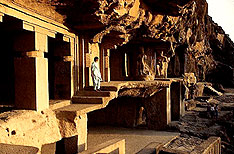 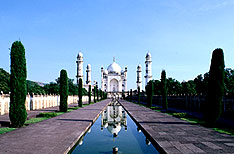 About Aurangabad The take off point, for visiting some of the subcontinents greatest art treasures at Ajanta and Ellora, is Aurangabad. A hot tourist destination in the 80's, it is named after the Mughal emperor Aurangzeb. Once a major center of power, now recalled by several evocative Muslim monuments, it has gained in stature, as an industrial town in the last decade. It also known as Sambhaji Nagar, Aurangabad also houses a Taj Mahal look like mausoleum, historic towns like Khultabad, Pitalkore and Paithan. One of the lesser-known discoveries, a 50,000-year-old meteorite impact crater, may fascinate the new age traveler. It is also a place to stay when visiting the caves of Ajanta, Ellora and the Grishneshwar temple. HISTORYOriginally known as Khadke, Aurangabad city was founded in 1610 by Malik Ambar, and an Abyssinian slave who became the Prime Minister to the king of Ahmednagar. When Fateh Khan, Malik Ambar's son turned successor in 1626, he gave the city the name Fatehpur. Later in 1653, when Prince Aurangazeb became viceroy of the Deccan, he made the city his capital and called it Aurangabad. His wife is buried in the Bibi Ka Maqbara and he is buried in a simple grave at Rauza. It acted as the centre of operations for his Deccan campaign, which occupied him for the second, half of his 49-year reign. CULTUREAurangabad has always been a prominent region on the Deccan Plateau. Having been inhabited since the Stone Age, it has a long artistic and cultural history - to which several dynasties have made major contributions over the years. Today, it has a university, medical as well as engineering colleges and is one of the India?s fastest growing cities. Further, compared to other Deccan towns, Aurangabad is uncrowned and quite. It is popular for its Bidriware, which is one of the ancient professions of Aurangabad. During any festive season, the whole city of Aurangabad brightens up and there is lot of excitement in the air. FOODAccording to traditional practice, food is revered, as it is equivalent to Brahma. The local flavours are kokum (sweet/ sour fruit), coconut milk and the ever-present seafood. Aurangabad echoes Mughal preferences and offers a wide variety of lamb/ chicken dishes. Though all the top end hotels have excellent restaurants offering a wide range of cuisine. SHOPPINGAurangabad is well known for its soft and elegant Himroo shawls. The Mashru and Kimkhab shawls make for equally good buys. Also famous are the legendary Paithani sarees and the delicate Bidriware. Agate is a popular stone set in wonderful jewellery and is a great give-away. ENTERTAINMENTAgainst the dramatic backdrop of the Ellora Caves, surrounded by hundreds of sculptural and architectural splendours, is the Ellora Festival of Classical Dance and Music. Usually in March, this festival showcases the best talents and is a unique and charming way to experience the magnificent caves, imbibing centuries of history and culture. General Information of Aurangabad LOCATIONIn central Maharashtra, situated 388 km from Mumbai via Manmad or 400 km via Pune. How to Reach By AirIA (Tel: 0240-485 421) has daily flights from Mumbai and Delhi. Jet Airways (Tel: 0240-487 092) has a daily flight from Mumbai. Airport: 8 km east of the city at Chikalthana. By RailIs not on a direct rail route. Lies on the Manmad-Kachiguda section of South Central Railway. Trains coming in from Mumbai are the Tapovan Express and Devgiri Express. Hyderabad is one of the other cities connected to Aurangabad by two trains. Railway Station: Southwest of the city centre and accessible from a majority of the hotels. By RoadIs connected to Mumbai, Pune, Indore, Nasik and Manmad. Bus Terminus: In the central part of the city, 1.5 km from the railway station. CLIMATEAurangabad has a moderate climate and the temperature difference between summer and winter is not large. Summers are hot and winters warm. In summer the temperature ranges between 38?C and 24?C. The winter high and low range between 24?C and 13?C respectively. Tourist Attractions in Aurangabad Ajanta 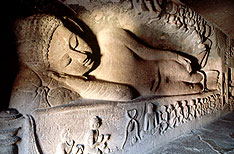 The splendid caves of Ajanta are not new to anyone. Nestling in the tranquil laps of the Sahyadri hills, at a distance of 100 km from Aurangabad are 30 rocks cut caves of Ajanta. The caves have on display, exquisite paintings, and sculptures depicting Buddha's life, halls and monasteries. These caves are older than those at Ellora and date from the 200 BC to 650 AD. They are cut from the volcanic lavas of the Deccan trap in a steep crescent shaped hillside in a forested ravine of the Sahyadris. After the late 7th century, the jungle took over and they lay unnoticed for centuries. Bibi ka Maqbara It is believed to be a mock-up of the Taj Mahal and is the only example of its kind in the Deccan plateau. Aurangzeb's son built this magnificent monument in the Mughal architectural style in 1679. Dedicated to his mother Begum Rabia Durani, the classic lines of a garden tomb give it an impressive setting. Daulatabad Situated on a pyramid-shaped hill, the fort with its slippery gravel pathways, spiked gates, spiral staircases and dungeons is a sight to behold. From Allaudin Khiljis capture of Deogarh fort in 1296 until Independence in 1947, the fort remained in Muslim hands with exclusive control with the Nizam of Hyderabad. The Persian style Chand Minar stands at the bottom of the fort, towering as a celebration of victory like the Qutb Minar in Delhi. It also houses the Jama Masjid with 106 pillars taken from a Hindu temple and the Chini Mahal where the last king of Golconda was imprisoned for 13 years. Ellora
Khuldabad Rauza or Khuldabad (Heavenly Abode) was once an important town around which Aurangzeb built a wall with 7 gates. The monument has serene austerity. The place is also famous for the Bhadra Hanuman or Hanuman in sleeping posture. Paithan Being an ancient taluka town, it is well known for the exquisite saris. Further, of the few attractions found nearby, the Jayakwadi dam is a treat to the eyes of the avid bird watchers. Next is the Dnyaneshwar Udyan, which is supposedly Maharashtras largest garden. Ghrishneshwar Temple
Pan Chakki This marvelous 17th century water mill was designed to generate energy to turn large stone of a flourmill. The name has been derived from the mill that crushed grain for the pilgrims. Further, there is a picturesque garden here that houses several beautiful fish tanks. On the same side of the Kham River, the Pan Chakki has a white marble shrine-paying abode to the memorial of a Sufi Saint Baba Shah Muzzafar, the devout Aurangzebs spiritual adviser. Others AURANGABAD CAVES - Just outside the city are located the sixth century caves. The caves are no doubt very interesting but are in no way substitute to Ajanta and Ellora. These caves display the influence of Tantric cult in the iconography and architectural designs of the caves. PAN CHAKKI - This marvelous 17th century water mill, was designed to generate energy to turn the large stone of a flourmill. The name has been derived from the mill that crushed grain for the pilgrims. |
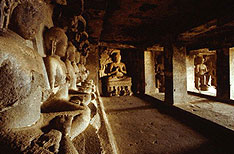 Ellora caves are again rock-cut caves with beautiful temples and monasteries. Situated at a distance of 30 km from Aurangabad, the Hindu, Jain and Buddhist caves carved in the volcanic rocks are among the finest in India. Lying near an important ancient trade route between Ujjain in Madhya Pradesh and the west coast, the caves are thought to be the work of priests and pilgrims who used the route. 34 caves in all, they are carved out of a single huge rock, with a gateway, pavilion, courtyard, vestibule, sanctum and tower. The Kailash Temple near the caves is a major attraction of this place.
Ellora caves are again rock-cut caves with beautiful temples and monasteries. Situated at a distance of 30 km from Aurangabad, the Hindu, Jain and Buddhist caves carved in the volcanic rocks are among the finest in India. Lying near an important ancient trade route between Ujjain in Madhya Pradesh and the west coast, the caves are thought to be the work of priests and pilgrims who used the route. 34 caves in all, they are carved out of a single huge rock, with a gateway, pavilion, courtyard, vestibule, sanctum and tower. The Kailash Temple near the caves is a major attraction of this place.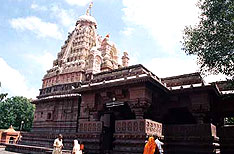 The temple just outside Ellora, houses one of the 12 Jyotirlingas of Lord Shiva. A fine example of medieval architecture, it was built by the Maratha princess Rani Ahilyabai Holkar. These temples are among the twelve Jyotirlingas of India.
The temple just outside Ellora, houses one of the 12 Jyotirlingas of Lord Shiva. A fine example of medieval architecture, it was built by the Maratha princess Rani Ahilyabai Holkar. These temples are among the twelve Jyotirlingas of India.